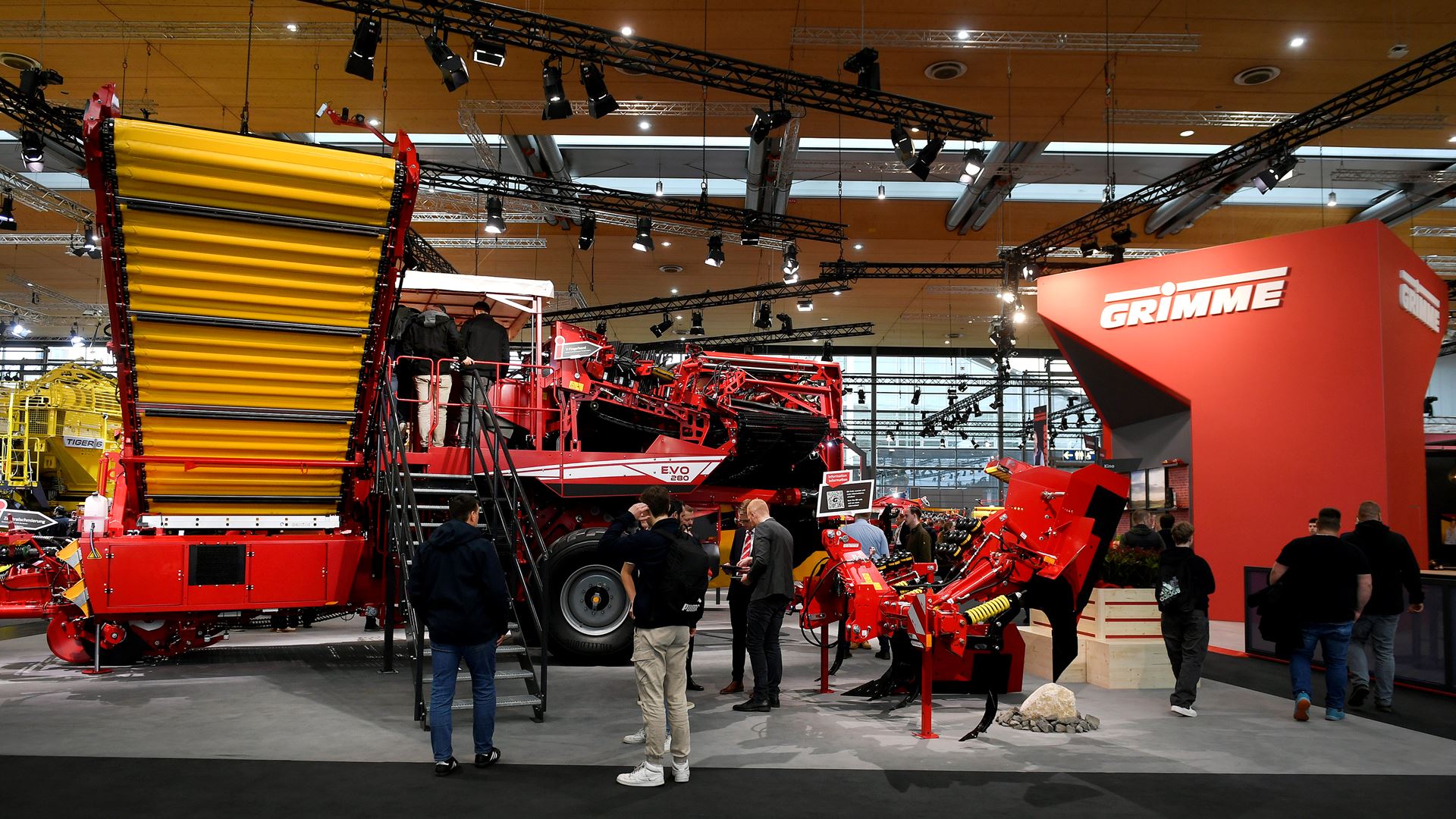21 October 2025 - Potato technology adapts to rising demand with efficient planting, flexible harvesting and automated storage systems for consistent quality and yield
By Dr. Rolf Peters, Visselhövede
Potato cultivation has expanded throughout Germany and Europe in recent years due to growing demand from the processing industry and satisfactory income levels for farmers. The manufacturers of potato technology have also benefited from this and adjusted their capacities accordingly.
Potato planting
A moderate expansion of individual potato cultivation areas can be most easily compensated for by allowing a slightly longer period of time for cultivation work. However, the unpredictable weather in recent springs has shown that increasing capacity utilisation in a commercially viable manner reaches its limits in terms of crop production when potatoes still have to be planted at the end of May/beginning of June. Against this background, many companies are switching from mounted to trailed machines. In addition to a larger seed hopper, they also allow easier combination with other process steps such as seedbed preparation, under-foot fertilisation and final ridge formation.
With a row width of 0.75 m, four-row planting machines dominate, as they can still be driven on public roads without major modifications. The transition to six or eight-row machines is usually achieved by means of foldable outer laying units, which are supplied from a central storage hopper via controlled feed belts. This design is not yet available for use in separate beds, meaning that two-row solutions predominate due to the basic row width of 0.90 m.
A key focus of discussion and development continues to be the "correct" shape of the final ridge, both in combination with laying and during subsequent ridging or tilling. Manufacturers now offer a wide range of rigid or rotating ridge formation elements to meet the varying requirements of farmers, from firm and smooth to loose and open-pored, and from pyramid-shaped to bulbous or with a very wide ridge crest. These can either be replaced as a complete unit or individually adjusted over a broad range using adjustable moulding elements on a tool.
Crop maintenance
Following the EU's refusal to extend the approval of metribuzin, the active ingredient predominantly used in potato cultivation to date, chemical weed control, especially in post-emergence, will become significantly more challenging. However, the use of mechanical maintenance measures is associated with an increased risk of damage to the roots and stolons, particularly in post-emergence, which can have a negative impact on plant growth. In addition, the challenges associated with ridge cultivation of potatoes become apparent here. This is because the cultivation tools must be easily adaptable to the aforementioned variety of ridge shapes in order to achieve the desired shape and structure while minimising damage to the plants.
This could be one reason why the development momentum in mechanical potato cultivation is currently significantly lower than in other row crops such as sugar beets or vegetables. In addition, the laying distances in the row, which vary considerably depending on the laying technique used, make it difficult to carry out mechanical treatment between plants. Although the use of RTK signals during potato planting makes it easier to achieve a working width for mechanical maintenance equipment that exceeds the number of rows of the planter, individually guided tools remain useful in order to be able to adapt to certain lateral and height variations during ridge formation.
In this context, agronomic measures such as good germination of the planting material, row spacing that is not too wide and the selection of varieties with rapidly developing foliage can also contribute to weed suppression. In particular, weeds that develop before the crop is established are highly competitive and have a decisive influence on subsequent weed pressure. Physical weed control methods prior to harvesting can significantly reduce any weeds that may be present. However, compared to chemical desiccation, they do little to prevent weeds from re-emerging. In practice, therefore, combined weed control methods are increasingly being used.
Harvest
With the increase in the area under potato cultivation, the time pressure during harvesting is also increasing, as the weather in some years sets clear limits for the end of the harvest window. On the other hand, the longer the tubers remain in the soil after dying or after the foliage has been reduced, the greater the risk of quality problems in the form of disease and pest infestation. Based on this experience, the market share of double-row bunker harvesters is growing steadily and has already replaced single-row machines as the standard machine in many regions of Germany.
In contrast, the next growth step has significantly more far-reaching implications for the organisation of harvesting. The purchase of an additional double-row bunker harvester also requires a second harvesting team, which often poses a challenge in terms of finding suitable tractor drivers and sorting personnel. In addition, procedural costs rise significantly, which initially tends to reverse the area reduction effect. At the same time, the subsequent transport and storage chain must be upgraded to ensure that the higher harvesting performance is consistently matched by an adapted storage capacity. The alternative purchase of a four-row self-propelled machine has so far been considered by only a few companies, as the soil quality and the amount of stones and clods in the soil often vary too greatly. In conjunction with the limited separation and sorting capabilities of four-row self-propelled machines, the proportion of foreign material in the harvested crop can increase and negatively impact the quality of the tubers as the crop is processed further. Separated areas would offer more favourable operating conditions here, but the four-row harvesters are too wide for road transport, at least in Germany, due to the prevailing row width of 0.90 m.
Separating potato fields before planting is a challenge in terms of time and cost, so farms are always looking for alternatives, such as using a two-row bunker harvester with pneumatic separation of foreign materials. Due to the arrangement of the separating device downstream of the sieve channel, the risk of damage is concentrated primarily in the front area of the crop flow through the harvester. However, in order to compare the two methods, the range of foreign materials on the farmland, the susceptibility of the main crop varieties to damage, and the desired grubbing performance must also be taken into account. Under very good harvesting conditions or with very high throughput, even the conventional scraper unit can become a bottleneck for the machine. As a result, operators equip their harvesters exclusively with the more conductive separation units consisting of rubber finger belts and inclined discharge rollers. For changing conditions, a double-row bunker harvester in the main separation unit has a discharge roller and a scraper module that can be used interchangeably. In addition, design solutions are being integrated into the revised series to make it quick and easy to replace the entire assembly.
Storage and retrieval
The limited availability of sorting personnel for the harvesting machines is being compensated for by the increasing use of automatic separation devices in the storage line. In addition to opto-electronic and physical detection systems, pneumatic solutions are also used to separate tuber-like foreign materials. The former can also be modified to sort out externally damaged or rotten tubers. Many devices are available in different working widths, so that the performance is sufficient even for the throughput of large rear intakes.
An increasing problem is the higher proportion of potato foliage in the harvested crop, some of which is not caught by the wide-meshed foliage chain of the harvester and is not collected by the few or absent sorting personnel. The stems in particular become lodged in the machines and can impair the functionality of entire processing systems over time. Inclined rubber finger belts are primarily offered for separation, but depending on the separation intensity and the content of foreign materials, these can significantly increase the risk of damage to the tubers due to the counterflow principle.
While opto-electronic sorting machines are now standard equipment in most operations for processing washed potatoes, this development is progressing much more slowly for unwashed potatoes. This is partly due to the fact that machines operating horizontally can only generate a maximum of three different quality or size fractions. For many companies, this is not sufficient for combining size sorting and quality sorting in a single operation. However, switching to a solution with horizontally arranged separation technology and a freely selectable number of outlets involves a significant increase in price, which often leads to the project being reconsidered or postponed. In addition, significant progress continues to be made in the development of technology for detecting abnormal tuber qualities, with improved camera technology, faster processors, and more powerful software. However, further adjustments are still required in practical continuous operation of horizontal machines with mechanical and pneumatic ejection technology. Despite intensive brushing of the potatoes, this is mainly due to residual soil, which causes unexpected wear and functional impairments that did not occur when the machines were originally developed for washed produce.
Storage
The growing demand for a year-round supply of domestic raw materials in many areas of recycling is leading to longer storage times overall. This in turn requires even greater independence from external temperature conditions. This is reflected both in the increasing prevalence of forced ventilation systems and the increased use of mechanical cooling systems. Direct airflow through the potatoes during forced ventilation enables more effective ventilation management thanks to the larger exchange surface between the air and the tubers. The result is faster and more targeted ventilation measures and significantly lower energy consumption, which should not be overlooked in light of the ongoing sustainability efforts within the potato value chain.
These efficiency benefits become even more important when using significantly more expensive mechanical refrigeration, while also contributing to greater storage reliability and consistent quality. Natural substances such as propane, which pose only a low risk to the environment, are increasingly being used as refrigerants in cooling systems. In addition, the technical assemblies and their joint control system are being optimised in order to further improve the efficiency of the entire line.
Media contact:
Malene Conlong
Tel: +49 6924788237
Email: M.conlong@dlg.org
About DLG
With more than 31,000 members, DLG is a politically independent and non-profit organisation. DLG draws on an international network of some 3,000 food and agricultural experts. DLG operates with subsidiaries in 10 countries and also organizes over 30 regional agricultural and livestock exhibitions worldwide. DLG’s leading international exhibitions, EuroTier for livestock farming and Agritechnica for agricultural machinery, which are held every two years in Hanover, Germany, provide international impetus for the local trade fairs. Headquartered in Frankfurt, Germany, DLG conducts practical trials and tests to keep its members informed of the latest developments. DLG’s sites include DLG's International Crop Production Centre, a 600-hectare test site in Bernburg-Strenzfeld, Germany and the DLG Test Centre, Europe's largest agricultural machinery test centre for Technology and Farm Inputs, located in Gross-Umstadt, Germany. DLG bridges the gap between theory and practice, as evidenced by more than 40 working groups of farmers, academics, agricultural equipment companies and organisations that continually compare advances in knowledge in specific areas such as irrigation and precision farming.

